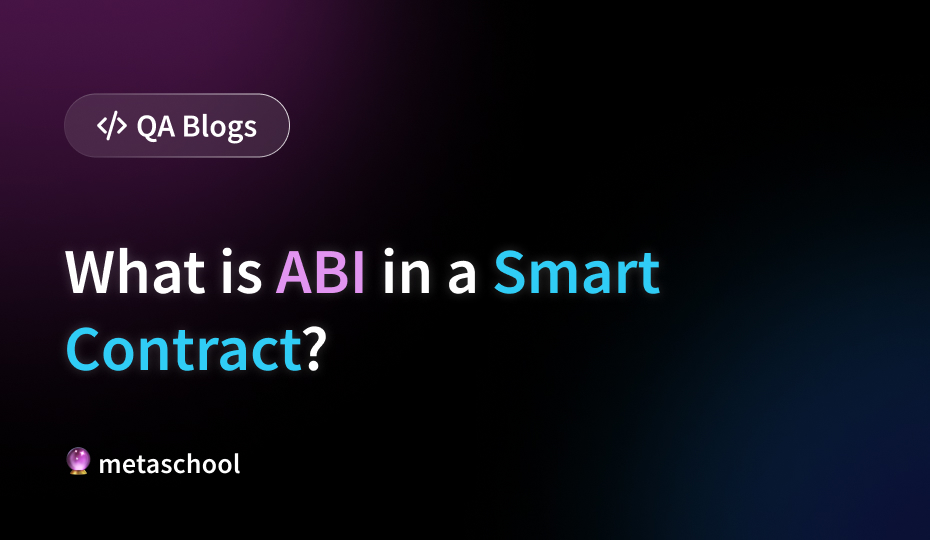Table of Contents
Imagine you’re moving into a new neighborhood filled with smart houses (contracts) on the blockchain block. You want to interact with your neighbors (call their functions) and understand what they’re all about (access their data). But these houses have their own language (bytecode) that might seem like gibberish at first. This is where the ABI (Application Binary Interface) comes in – it acts as a translator, bridging the gap between you and your smart contract neighbors.
The Interpreter for Smart Contract Communication
In the world of Solidity smart contracts, the ABI plays a crucial role in enabling communication between them and external applications. It essentially defines a common language for how data is structured and exchanged. Here’s a breakdown of what an ABI is and how it works:
- What it Does: The ABI acts as a blueprint or interface that specifies the functions a contract exposes, along with their parameters and return values. It’s like a detailed instruction manual for how to interact with the contract.
- Structure: An ABI is typically written in JSON (JavaScript Object Notation) format. This format makes it human-readable and easy for developers and tools to understand.
- Components: Here are some key components you’ll find within an ABI:
- Function Names: The names of the functions the contract exposes (like
transferorbalanceOf). - Function Parameters: The data types and names of the arguments expected by each function (e.g.,
address recipientoruint256 amount). - Return Values: The data types of the values returned by the functions (e.g.,
bool success). - Events (Optional): Some ABIs might also include definitions for events the contract can emit (more on events later).
- Function Names: The names of the functions the contract exposes (like
🔥 Check this course out: Build a Semi-Fungible ERC404 Tokens’ Marketplace
How ABI Facilitates Communication
- Contract Compilation: When you write a Solidity smart contract, you compile it into bytecode. This bytecode is the machine-readable code that gets deployed on the blockchain.
- ABI Generation: During compilation, the Solidity compiler also generates a separate ABI file in JSON format. This file describes the human-readable interface of the contract.
- Interaction Channels: There are two main ways developers and applications interact with smart contracts:
- On-chain Interaction: Another Solidity contract can directly call functions on a deployed contract. In this case, the calling contract would use the ABI to understand the function names, parameters, and return values to properly interact with the target contract.
- Off-chain Interaction: External applications (like web wallets or user interfaces) can’t directly interact with blockchain contracts. They typically use tools and libraries that connect to a blockchain node. These tools rely on the ABI to understand the contract’s functions and data structures, allowing them to effectively send transactions and interpret the results.
Example: A Token Contract with ABI
Let’s consider a simple token contract where users can hold and transfer tokens. Here’s a glimpse of what the ABI might look like (without all the details):
[
{
"name": "transfer",
"inputs": [
{ "name": "_to", "type": "address" },
{ "name": "_value", "type": "uint256" }
],
"outputs": [
{ "name": "", "type": "bool" }
]
},
{
"name": "balanceOf",
"inputs": [
{ "name": "_owner", "type": "address" }
],
"outputs": [
{ "name": "balance", "type": "uint256" }
]
}
]
This ABI snippet shows two functions:
transfer(address _to, uint256 _value): This function allows transferring tokens from the current user to another address (_to) with a specified amount (_value). It returns a boolean value indicating success or failure.balanceOf(address _owner): This function takes an address (_owner) and returns the balance of tokens held by that address.
Beyond the Basics: Events and More
While the core functionality revolves around function definitions, ABIs can also include information about events a contract can emit. Events act as a way for contracts to broadcast important happenings (like a successful transfer) to the blockchain. The ABI can specify the event names, data types of the information included in the event, and allow external applications to listen for these events and react accordingly.
🔥 Check this course out: Build Hogwarts Sorting Hat dApp on Polygon
Importance in Smart Contract Development
Here’s why ABI is a vital part of the smart contract development ecosystem:
- Standardization: ABI provides a common language for interaction between contracts and external applications. This standardization makes development easier and ensures different tools can understand and interact with contracts seamlessly.
- Maintainability: A well-defined ABI acts as clear documentation for your contract’s functions and data structures. This makes it easier for other developers to understand how to interact with your contract and promotes code maintainability in the long run.
- Flexibility: The ABI separates the contract’s logic (bytecode) from its interface. This allows for changes to the contract’s implementation without necessarily breaking existing applications that interact with it as long as the function names, parameters, and return values remain consistent within the ABI.
Conclusion
The ABI acts as a critical bridge between smart contracts and the outside world. It facilitates communication by providing a standardized interface for interaction. By understanding how ABIs work, you’re better equipped to develop robust and user-friendly smart contracts that can seamlessly integrate with various tools and applications within the blockchain ecosystem. So, the next time you encounter an ABI, remember it’s not just a technical detail – it’s the translator that allows your smart contract to chat with the world!
Try it out, ask us questions, and tell us how it went by tagging Metaschool on Social Media.
Follow us on –
🔮Twitter – https://twitter.com/0xmetaschool
🔗LinkedIn – https://www.linkedin.com/company/0xmetaschool/
